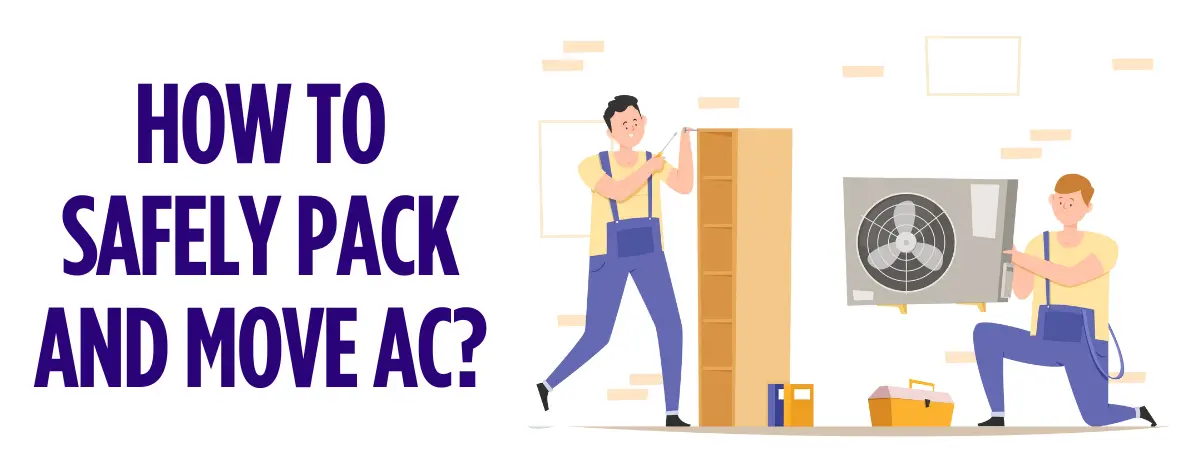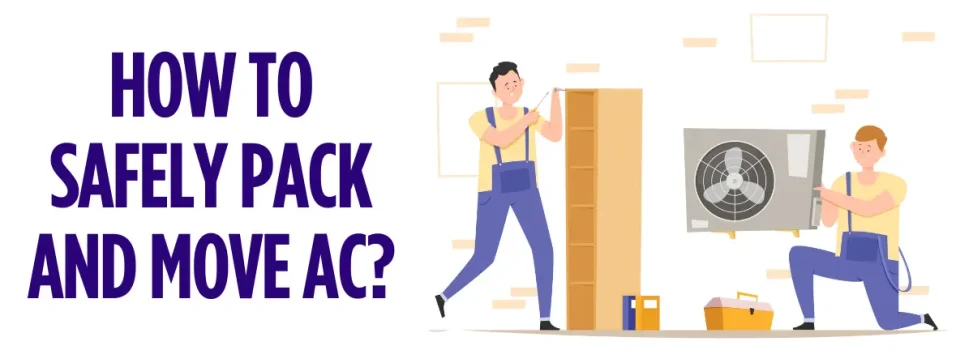It can be difficult to relocate to a new house or place of business, particularly if you have to transport big, heavy things like air conditioners (ACs). Since air conditioners are necessary for a pleasant place to live or office, it’s critical to pack and relocate them carefully to prevent damage. We’ll go over some advice on safely packing and moving your air conditioner in this article.
Switch the AC off and unplug it:-
Be careful to unhook the AC from the electrical outlet and switch it off before you begin packaging. By doing this, you can avoid wiring mishaps, and the air conditioning won’t run when it’s getting relocated.
Dust off the air conditioner:-
Eventually, contaminants such as dust can build up inside the air conditioner, decreasing its effectiveness and possibly posing health risks. As a result, cleaning the AC is crucial before storing it.
Refresh the air filters after removing them, use a fresh cloth to wash out the AC’s exterior, and take away any inside dirt.
Brush the aluminum fins, use compressed air to expel the coils, vacuum, and clean the inner tray. Utilize an oxygenated home cleanser or coil cleaner for a thorough cleaning when the unit is particularly filthy.
Collect the essential packaging supplies:-
To save your air conditioner throughout the relocation, gather some packaging supplies: moving blankets, bubble wrap, wrapping paper, packing adhesive, and a moving dolly.
Cover the AC with moving blankets and bubble wrap:-
Continue by covering the air conditioner with bubble wrap after it has been dusted to prevent scrapes and other damage. Wrap the top and bottom of the air conditioner as well as all of its sides.
To add additional padding and security, place a moving blanket over the air conditioner once it has been wrapped in bubble wrap.
Fasten the packaging firmly with tape:-
Cover the moving blanket and bubble wrap surrounding the air conditioner securely using packing tape. To stop any kind of motion during the relocation, verify that the tape is securely covering all over the entire AC.
Put a label on the air conditioner box.
Labeling the box once the air conditioner has been packaged inside will help you avoid getting mixed up with the remaining carefully packaged boxes.
Reinstalling:
You will need to replace the air-conditioning unit once you have safely relocated into your new home. To keep a suitable temperature in the area, you must select a spot where you would like to set up the unit and make sure the window is securely sealed.
Assistance from the professional side:-
If you’re not confident moving your air conditioner on your own, you might want to think about hiring movers with skills in managing heavy, bulky objects like air conditioners. They’ll be ready with the tools and know-how needed to make the move comfortable and risk-free.
You should be aware of how heavy AC units are. To deal with it properly would require skills and experience that only specialists have. The moving professionals will cautiously detach the item at this stage, particularly if it is on a windowsill.
Additionally, they possess the equipment needed to remove the unit, such as screwdrivers, grip gloves, thick clothes to leave in water, a dolly to transport your air conditioner so it can be put onto a truck, and a durable bag to store your detachable parts. Additionally, they will handle anything related to the AC’s hose or the location where hot air exits.
The expert packers and movers will properly cushion your air conditioner with Styrofoam and, if necessary, cover it in bubble sheets before placing it in a box. They will also attempt to tape the AC’s removable sections using it alone. It will be a little difficult to slide into the box, but once it is, everything will be kept secure and in one location.
Is it possible to damage the Air Conditioner During Transport?
Absolutely, but it additionally relies on how cautiously you move it. There is a chance that an air conditioner could be harmed when you fail to understand how to take care of and carry it carefully. Therefore, before trying to shift an air conditioning unit on your own, take the time to verify and find out how to transfer specific items, such as your AC unit.
Moving an air conditioner may have the following risks:-
- Another delicate component of an air conditioner that could sustain damage in transit is the refrigerant pipeline. Should these pipes burst or leak, your system won’t have any refrigerant and won’t function correctly when you set it in your new house. If this occurs, you will need to pay for labor and installation fees once more when you set up an updated system at your house.
- Not handling them carefully can also harm the fan blades. The air conditioner will operate less effectively and consume more energy when the fan blades are twisted or broken. Your electricity bills will go up as a result, as well as when the damage is significant enough, you might even need to get a new air conditioner installed.
- An additional moving component of an air conditioner that is susceptible to damage while being transported is the compressor. Your air conditioner won’t function when the compressor has become defective since it won’t be able to circulate the refrigerant efficiently.
- Your home receives chilly air because the freon gas will cool the compressor. While using air-conditioning equipment, freon gas leaks might occur. The leak will harm you, your loved ones, and your pets. Shifting an air conditioner without following the right procedures could result in Freon leakage and compressor issues.
It takes meticulous preparation and close attention to specifics to pack and relocate your air conditioner. You can make sure that your shipment of air conditioner securely reaches your new residence or place of business undamaged by adhering to these suggestions. To ensure the effectiveness of your move, always prioritize your time and, if necessary, get professional assistance from packers and movers of 1Support.
FAQs
The travel time of the trip and the service you choose will determine how much it costs to transport an air conditioner. Simply enter your shipping details (pick-up and delivery addresses, package weight and sizes, etc.) in the 1Support booking tool, and you can
Receive a fast quote.
It is advisable to pack the air conditioner carefully during transit to safeguard it. If you would like a vehicle specifically for your cargo for transferring the air conditioner system, you can reserve our service. The assistance of 1Support is the most practical and secure method for moving air conditioners.
It is strongly advised against sending the air conditioner via courier upside-down or on its side. The compressor attachment may sustain damage as a result of this positioning. If you transport the air conditioner, keep it on its side, allow it to settle straight for one hour before operating it.
Depending on the shipping option you select and how far it is between the pick-up and delivery destinations, the time it takes to deliver your AC unit will vary. When placing an order, the scheduled arrival time will be shown on the portal.


